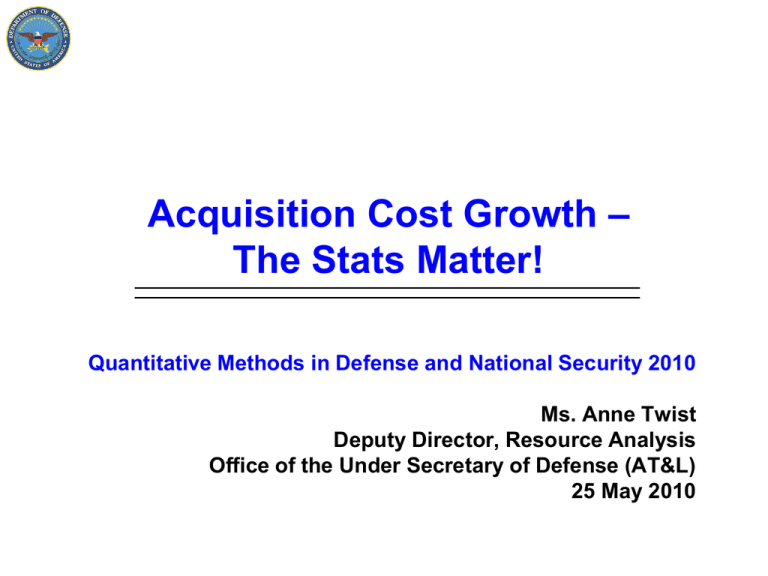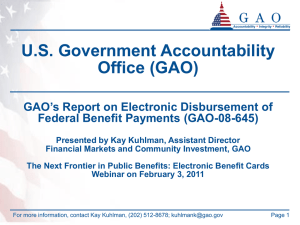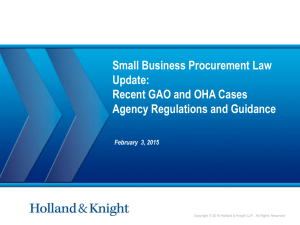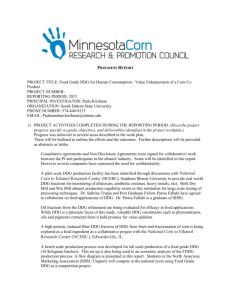ADM Guidance vs. POM10-15 Funding for Milestone B
advertisement

Acquisition Cost Growth – The Stats Matter! Quantitative Methods in Defense and National Security 2010 Ms. Anne Twist Deputy Director, Resource Analysis Office of the Under Secretary of Defense (AT&L) 25 May 2010 MDAP Portfolio Tornado Chart JSF (F-35) BMDS SSN 774 DDG 51 Destroyer C-17A F-22 Raptor V-22 (OSPREY) F/A-18E/F CVN 21 TRIDENT II MISSILE Joint MRAP Sunk Cost -100 P-8A PATRIOT/MEADS CAP Chem Demil-CMA CH-53K Program BLACK HAWK UH-60M AMRAAM (AIM-120) FMTV DDG 1000 Destroyer JTRS GMR E-2D AHE LPD 17 CLASS WIN-T INCREMENT 3 EFV (Formerly AAAV) Stryker C-130J Hercules SBIRS High BAMS MH-60R Global Hawk CH-47F LONGBOW APACHE Advanced EHF USMC H-1 UPGRADES REAPER EA-18G PATRIOT PAC-3 AB3 AMF JTRS Navstar GPS Chem Demil-ACWA JLENS MH-60S JASSM C-5 RERP MUOS TOMAHAWK(R/UGM-109E) LHA 6 SM-6 C-130 AMP GMLRS IAMD JDAM JPATS JTRS HMS ER/MP UAS JSOW WIN-T Increment 2 CEC ATIRCM/CMWS GPS-IIIA FAB-T JHSV FBCB2 WIN-T Increment 1 LITTORAL COMBAT SHIP AIM-9X WGS PREDATOR Inc 1 E-IBCT VTUAV MIDS Excalibur IDECM NMT HIMARS JCA LUH, UH-72A Lakota JTRS NED AGM-88E AARGM COBRA JUDY REPLACEMENT NAS RMS B-2 RMP MP-RTIP C-5 AMP EA-6B ICAP III GBS JPALS SBSS BLOCK 10 B-2 EHF ASIP LAIRCM -50 0 Remaining Cost (FY11+) 50 100 150 200 250 300 Investment Funding (TY$B) We have a bad behaving population of MDAPs; the magnitude of the JSF program makes portfolio-wide statistics meaningless. Measuring portfolio cost growth and other similar statistics is Bad Math. 2 Measuring Cost Growth: GAO Method vs. AT&L Method The Stats Matter! Doomsday Press Reports April 1, 2008: The Government Accountability Office found that 95 major systems have exceeded their original budgets by a total of $295 billion, bringing their total cost to $1.6 trillion, and are delivered almost two years late on average. In addition, none of the systems that the GAO looked at had met all of the standards for best management practices during their development stages. Auditors said the Defense Department showed few signs of improvement since the GAO began issuing its annual assessments of selected weapons systems six years ago. "It's not getting any better by any means," said Michael Sullivan, director of the GAO's acquisition and sourcing team. "It's taking longer and costing more." March 31, 2009: Development costs for the Pentagon's major weapons systems soared last year, helping drive overruns that are "staggering," the Government Accountability Office said in a report released yesterday. Overall, the cost overruns associated with the military's major weapons …”total near $300 billion, and the average program delay has stretched from 21 to 22 months,” The figures reflect a weapons development and procurement system that is woefully broken… “Pentagon planners don't do a good enough job of analyzing those requirements to understand whether they have the technologies and designs to build to them," GAO analyst Michael J. Sullivan said. 4 Measuring Cost Growth: GAO Method vs. AT&L Method • • • • GAO Methodology Single Program Example: DDG 51 Oldest 10 programs MDAP Portfolio “The new GAO report continues to sensationalize the assessed cost growth of $296 billion on 96 programs. This number has been cited by many people as a condemnation of the defense procurement process. I have analyzed the components of this GAO number, and I would suggest that the number is misleading, out-of-date, and largely irrelevant to the current management of DoD programs.” --Mr. John J. Young, former USD(AT&L), 2009 The Stats Matter! GAO Methodology • GAO publishes an annual report on cost growth – Summarizes all Major Defense Acquisition Programs (MDAPs) – highlight is their “Total Cost Growth” calculation – The FY10 report did not give a total cost growth figure • GAO defines cost growth as the change in total program acquisition costs from the first original estimate to the current estimate • Problems with GAO’s methodology: 1) Procurement of additional quantities and/or required capability counts as cost growth 2) Poor early performers can never recover, even if they have been performing well for many years 3) Differing “portfolios” compared on an annual basis 4) Pre-Milestone B estimates used (i.e., before the program defined) 5) Acquisition painted with broad brush as if all programs are broken 6 GAO Methodology • Quantity growth and age of the programs greatly inflate cost growth • The fine print…. – Past sins are never forgiven: Many programs have been in the portfolio for more than 15 years and continue to carry huge cost growth figures even if they have been performing well for years – Quantity Changes are Leadership Decision to Shape the Force: Procurement of additional quantities and/or required capability is included in GAO’s cost growth calculation, often making more desired programs appear to be broken • These two factors consistently had impact on program cost, and therefore we must isolate these factors to really understand what drives cost growth Focus on Measurement: Cost growth is an issue that must be controlled; however, the amount of cost growth has been significantly overstated. 7 DDG 51 Example The DDG 51 is a multi-mission guided missile destroyer designed to operate offensively and defensively, independently, or as units of Carrier Strike Groups (CSG), Expeditionary Strike Groups (ESG), and Missile Defense Action Groups in multi-threat environments that include air, surface, and subsurface threats. These ships will respond to Low Intensity Conflict/Coastal and Littoral Offshore Warfare (LIC/CALOW) scenarios as well as open ocean conflict providing or augmenting power projection, forward presence requirements, and escort operations at sea. 8 GAO Method: DDG 51 Program Original Estimate to Current DDG 51 Destroyer Original Current Cost Growth (GAO MS B Date Estimate ($B) Estimate ($B) Method) ($B) Feb 1988 27.6 93.4 65.8 PAUC = Program Acquisition Unit Cost • GAO Method simply subtracts the Original estimate from the Current estimate to calculate the total program cost growth • DDG 51 had a MS B in February, 1988. At that time, only 23 units were planned to be produced. The Dec 2009 SAR estimate shows that DoD now plans to procure 71 units • The increase in unit cost for DDG 51 is relatively small; however it is incurring a huge cost growth penalty for its increase in quantity • The increase in quantity was a leadership decision driven by the fact that this is a successful program – according to GAO, this is one of the worst performers in the inventory! 9 AT&L Method: DDG 51 Program 5 Year Estimate DEC04 DEC04 to Current MS B Date Quantity PAUC ($B) DDG 51 Destroyer Feb 1988 62 1.2 Current Current Quantity PAUC ($B) 71 1.3 Actual Cost Unit Cost Quantity Cost Growth (ARA Growth ($B) Growth ($B) Method) ($B) 4.3 11.8 4.3 PAUC = Program Acquisition Unit Cost • First, we eliminate historical bias by comparing the Current Estimate to the 5 year prior estimate • Second, we separate cost growth due to changes in unit cost from cost growth strictly due to quantity increases • The difference between GAO Method and AT&L Method is significant in many programs – for DDG 51 it is about a $61.5B difference • We used this process for about 100 MDAPs, and saw that when quantity is considered, Actual Cost Growth becomes very concentrated among a few programs 10 Oldest 10 Programs: GAO Method All data are in BY$10 Billions Index 1 2 3 4 5 6 7 8 9 10 Older Acquisition Programs TRIDENT II (D-5) MISSILE DDG 51 Destroyer V-22 OSPREY FMTV AMRAAM C-17A F-22 Raptor F/A-18E/F JSOW Baseline/BLU-108 CVN-77 First Original APB Jul 1987 Feb 1988 Feb 1988 Oct 1988 Dec 1988 Dec 1988 Feb 1992 Jun 1992 Jun 1992 Jun 1993 Sub-total ($B) First Original Estimate Dec 09 SAR Estimate 50.4 27.6 31.4 10.2 16.4 50.1 89.0 79.7 2.8 6.1 50.9 93.4 55.5 21.1 23.8 81.5 76.6 54.1 2.2 6.8 363.7 465.9 GAO Cost Growth ($B) from MS B 0.5 65.8 24.1 10.9 7.4 31.4 -12.4 -25.6 -0.6 0.7 102.2 • If we replicate the GAO Method using Dec 2009 SARs, the 10 oldest programs (out of a total of 98) account for $102.2B of cost growth 11 Oldest 10 Programs: AT&L Method All data are in BY$10 Billions Index 1 2 3 4 5 6 7 8 9 10 Older Acquisition Programs TRIDENT II (D-5) MISSILE DDG 51 Destroyer V-22 OSPREY FMTV AMRAAM C-17A F-22 Raptor F/A-18E/F JSOW Baseline/BLU-108 CVN-77 First Original APB Jul 1987 Feb 1988 Feb 1988 Oct 1988 Dec 1988 Dec 1988 Feb 1992 Jun 1992 Jun 1992 Jun 1993 Sub-total ($B) First Original Estimate Dec 09 SAR Estimate 50.4 27.6 31.4 10.2 16.4 50.1 89.0 79.7 2.8 6.1 50.9 93.4 55.5 21.1 23.8 81.5 76.6 54.1 2.2 6.8 363.7 465.9 GAO Cost AT&L Cost Growth Growth ($B) from ($B) last 5 MS B years 0.5 2.1 65.8 4.3 24.1 1.8 10.9 3.4 7.4 2.3 31.4 -5.8 -12.4 2.0 -25.6 -1.7 -0.6 0.0 0.7 -0.3 102.2 8.2 • From earlier slide, GAO method shows that the 10 oldest programs account for $102.2B of cost growth • When we account for age of the program and quantity increases, the AT&L actual cost growth for these same 10 programs is $8.2B! 12 GAO Method: FY10 MDAP Portfolio 100 80 Portfolio Cost Growth $B 60 40 20 JSF $281B DDG 51 $93B C17A $82B V-22 $56B SSN 774 $81B FMTV $21B AMRAAM$24B 0 Total Program Cost is represented by the size of the circle Apache $14B C-130J $15B CH-47F $13B Blackhawk $22B MRAP $38B Trident II $51B F-22 $77B -20 DDG 1000 $20B F/A-18 $54B -40 1985 1990 1995 2000 2005 2010 2015 Milestone B Date Using GAO Method, cost growth is concentrated in JSF and several very old programs, many of which have been performing well for some time. 13 AT&L Method: FY10 MDAP Portfolio 100 80 Portfolio Cost Growth $B 60 JSF $281B Total Program Cost is represented by the size of the circle 40 The Stats Matter! 20 0 DDG 51 Trident II $93B $51B C17A $82B F-22 $77B F/A-18 $54B CVN 21 $34B SSN 774 $81B GMLRS $6B MRAP $38B DDG 1000 $20B -20 -40 1985 1990 1995 2000 2005 2010 2015 Milestone B Date Using AT&L Method, it is obvious that JSF and a small set of troubled programs account for the bulk of cost growth. 14 Cost Growth or Capability Trade-off? • There are numerous methods we can use to classify cost growth, but the real issue is determining what capability can be supplied to the warfighter in a given period of time • Sometimes we are willing to “pay,” or incur cost growth for capability – Immediate warfighting needs – Necessary quantity or technology increase – Flexibility from numerous simultaneous acquisition programs – Efficient production schedules • Other times cost growth is not willingly incurred – Poor initial cost estimates – Poor program management – Unrealistic expectations – Premature technology – Redundant capability • Reducing the capability lost to the warfighter as a result of unplanned cost growth should be our primary focus! 15 F-22 Funding Example The F-22 combines stealth, speed, maneuverability, integrated avionics, multirole precision attack, and improved supportability. It is a critical component of the Global Strike concept of operations with unmatched air-to-air and air-toground capabilities. The Raptor ensures air dominance, rapidly and at great distances, by countering and defeating threats, including those attacking friendly forces and those attempting to deny access by our forces. 16 F-22 RDT&E Program Funding FY85$M 4000 3500 80% 60% 40% 20% 0% -20% -40% Total R&D Program Cost Relative to Original Baseline SAR Date 3000 2500 2000 1500 1000 500 0 83 84 85 86 87 88 89 90 91 92 93 94 95 96 97 98 99 '00 '01 '02 '03 '04 '05 '06 '07 '08 17 F-22 RDT&E Program Funding FY85$M 4000 MS B: Feb 1992 Original Unit Cost: $137M Current Unit Cost: $408M 3500 80% 60% 40% 20% 0% -20% -40% Total R&D Program Cost Relative to Original Baseline SAR Date 3000 Original Estimate 2500 2000 1500 Current Estimate 1000 500 0 83 84 85 86 87 88 89 90 91 92 93 94 95 96 97 98 99 '00 '01 '02 '03 '04 '05 '06 '07 '08 18 Acquisition Reform Initiatives • Weapon Systems Acquisition Reform Act (WSARA) of 2009 • MS A and MS B Certifications • IMROVE Acquisition Act: HR 5013 • QDR & FY11 Budget • Acquisition Workforce Reform • Tactical Acquisition Reform • Strategic Acquisition Reform 19 WSARA Funding Requirements • OSD(CAPE) responsible for developing guidance governing cost estimation and cost analysis processes, including confidence levels for cost estimates and conducting independent estimates/analyses for all MDAP and MAIS for which USD(AT&L) is the Milestone Decision Authority (MDA) • D,CAPE and the Secretaries of Military Departments must disclose the confidence level used in cost estimates for MDAPs/MAISs • If less than 80 percent, include such disclosure in any documentation approving a cost estimate, and in the next Selected Acquisition Report (SAR) or quarterly report 20 Funding to 80% Confidence Level • Previously, MDAPs were funded so it was equally likely that actual costs will be higher or lower than the estimate • Problems with funding to the 80% confidence level: – What is the underlying distribution? – Money into the program is more than we expect to spend is this a self-fulfilling prophecy? • MDAP spending in 2011 is $77B – what would it be if we had to fund to 80% confidence level? 21 Ongoing Studies • Numerous studies on program stability and portfolio cost growth have been done • Common themes: – Funding Stability – PM Tenure – Accurate cost estimates – Requirements Creep • AT&L is aggressively addressing cost growth: – Formation of a Value Team, headed by the PDUSD(AT&L) – MDAP Transparency Study to identify program costs in the financial & acquisition databases 22 Conclusions • When controlled for quantity and time, cost growth becomes a much more manageable problem for the Department • Not all cost growth is bad. There are smart and necessary capability increases to platforms that result from deliberate & intelligent decision making for the benefit of the warfighter and National Security • Large cost growth in individual acquisition programs is the exception, not the rule • The Department continues to implement many policies & procedures to help control cost growth – results indicate they are working! • The Stats Matter! 23










